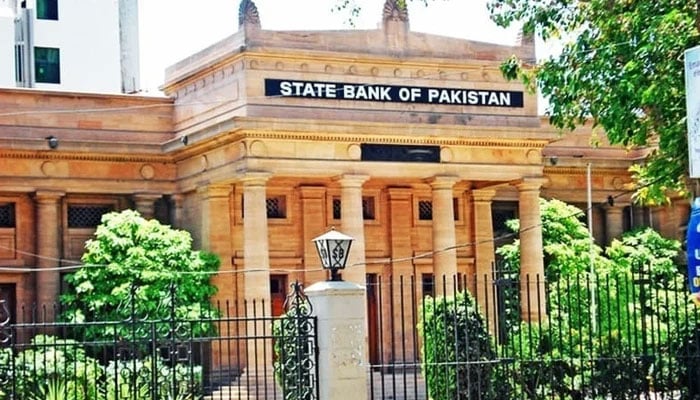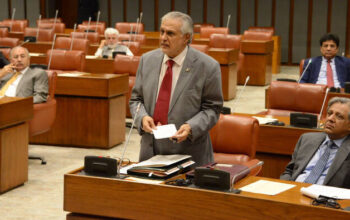By Staff Reporter
KARACHI: Pakistan’s central bank left its benchmark interest rate unchanged at 11 percent on Monday, signaling a cautious stance as inflation edges higher and economic growth gathers pace.
The Monetary Policy Committee (MPC) said the uptick in inflation to 3.5% year-on-year in May was in line with its forecasts, while core inflation eased slightly, reinforcing its view that the current rate level is sufficient to anchor price stability within the 5-7% target range through fiscal year 2026.
“The Monetary Policy Committee (MPC) decided to keep the policy rate unchanged at 11 percent,” the State Bank of Pakistan (SBP) said in a statement.
The decision reflects a balancing act between supporting a nascent recovery, projected to strengthen next year, and guarding against external risks, including a widening trade deficit and sluggish financial inflows. “The Committee deemed today’s decision appropriate to sustain the macroeconomic and price stability,” the central bank said.
Brokerage houses have dialed back expectations for a rate cut by after Israeli strikes on Iran ignited fears of a wider conflict, sending oil prices surging. The attacks on Friday have heightened concerns over tightening crude supplies and prolonged hostilities, threatening Pakistan with imported inflation.
In a Reuters snap poll, 11 of 14 respondents see the State Bank of Pakistan (SBP) holding its benchmark rate steady at 11%, while two predict a 100 basis-point cut and one anticipates a 50 basis-point reduction.
The central bank said headline inflation climbed to 3.5% in May from 0.3% in April, driven by the fading of favorable base effects from food prices and persistent core inflation. Energy prices, however, remained subdued compared to last year, thanks to earlier moderation in global oil markets. Despite the increase, inflation expectations among households and businesses have moderated, offering some relief to policymakers.
The committee expects inflation to rise gradually before settling within its 5-7% target range in FY26. That outlook, however, hinges on several variables. “This remains subject to multiple risks emanating from potential supply-chain disruptions from regional geopolitical conflicts, volatility in oil and other commodity prices, and the timing and magnitude of domestic energy price adjustments,” the central bank warned.
Recent budgetary measures proposed for FY26 are expected to have a limited impact on inflation, though near-term volatility could emerge, the statement added. Still, it assessed that the real interest rate, currently in positive territory, remains “adequately positive to stabilize inflation” over the medium term.
Economic activity is gaining traction, with real GDP growth for FY25 provisionally pegged at 2.7%. The second half of the year saw a notable acceleration to 3.9% from 1.4% in the first half, fueled by stronger industrial and services output. Agriculture, however, lagged due to a sharp drop in major crop production.
Looking ahead, the MPC anticipates growth will climb further in FY26, with the government targeting 4.2%. “The industry and services sectors [are expected] to continue to drive economic growth,” the committee said, citing robust high-frequency indicators like private-sector credit, machinery imports, and business sentiment, alongside easing financial conditions. Agriculture prospects, however, remain dim due to unfavorable weather affecting Kharif crops.
On the external front, the current account posted a near-zero balance in April, lifting the July-April FY25 surplus to $1.9 billion. Strong workers’ remittances offset a widening trade deficit, though export growth slowed amid a tough global trade climate. The SBP’s foreign exchange reserves rose to $11.7 billion as of June 6, bolstered by a $1 billion disbursement from the first Extended Fund Facility review. Reserves are projected to hit $14 billion by June 2025, despite weak net financial inflows so far.
Still, risks are mounting. “The uncertain global trade environment, coupled with expected continued strong import demand, is projected to turn the current account into a moderate deficit in FY26,” the MPC said. Proposed FY26 budget measures could exacerbate import pressures, while geopolitical tensions and volatile oil prices add uncertainty.
Fiscal consolidation is advancing, with revised FY25 estimates showing a primary surplus of 2.2% of GDP, up from 0.9% the prior year, driven by higher revenues and restrained spending. For FY26, the government aims for a 2.4% surplus, though domestic borrowing has surged amid a shortfall in external financing.
“The MPC emphasized achieving the envisaged fiscal consolidation by pursuing effective and timely implementation of reforms, especially broadening the tax base and privatizing or reforming PSEs,” the statement said.
Globally, oil prices have surged due to Middle East tensions and easing U.S.-China trade frictions, posing a potential threat to Pakistan’s import bill and inflation outlook. The MPC flagged these developments as key variables to watch.
Broad money (M2) growth slowed to 12.6% as of May 30 from 13.3% at the last meeting, reflecting a drop in net budgetary borrowing. Private-sector credit, however, held firm at 11%, with textiles, telecom, and retail leading the charge, alongside robust consumer finance growth. Reserve money spiked due to seasonal Eid-related cash demand, prompting the central bank to inject liquidity to keep interbank rates aligned with the policy rate.
Copyright © 2021 Independent Pakistan | All rights reserved




